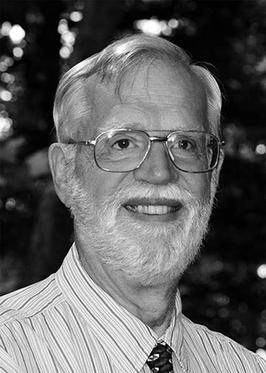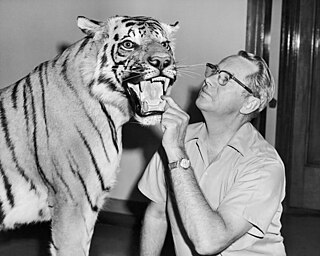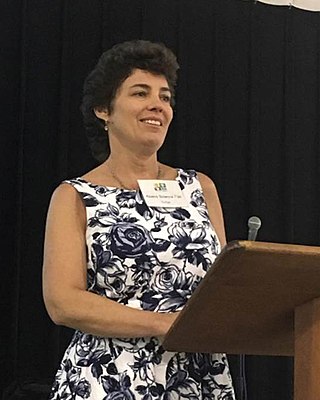Related Research Articles

Spencer Fullerton Baird was an American naturalist, ornithologist, ichthyologist, herpetologist, and museum curator. Baird was the first curator to be named at the Smithsonian Institution. He eventually served as assistant Secretary of the Smithsonian from 1850 to 1878, and as Secretary from 1878 until 1887. He was dedicated to expanding the natural history collections of the Smithsonian which he increased from 6,000 specimens in 1850 to over 2 million by the time of his death. He published over 1,000 works during his lifetime.

James Lauritz Reveal was a U.S. botanist best known for his contributions to the genus Eriogonum and for his work on suprageneric names. His website, at PlantSystematics.org, also presents material on plant taxonomy including the Reveal system. He published extensively on North American flora, was a member of the Angiosperm Phylogeny Group, and was one of the authors of the APG II and APG III classifications.
Karl Patterson Schmidt was an American herpetologist.
Hobart Muir Smith, born Frederick William Stouffer, was an American herpetologist. He is credited with describing more than 100 new species of American reptiles and amphibians. In addition, he has been honored by having at least six species named after him, including the southwestern blackhead snake, Smith's earth snake, Smith's arboreal alligator lizard, Hobart's anadia, Hobart Smith's anole, and Smith's rose-bellied lizard. At 100 years of age, Smith continued to be an active and productive herpetologist. Although he published on a wide range of herpetological subjects, his main focus throughout his career was on the amphibians and reptiles of Mexico, including taxonomy, bibliographies, and history. Having published more than 1,600 manuscripts, he surpassed all contemporaries and remains the most published herpetologist of all time.
Norman Edouard "Kibe" Hartweg was an American herpetologist, Curator of Herpetology for the Museum of Zoology at the University of Michigan, and president of the American Society of Ichthyologists and Herpetologists. He was a specialist in the taxonomy and distribution of turtles, and is honored by having a subspecies of turtle named after him: the western spiny softshell turtle, Apalone spinifera hartwegi. He is also credited with having described several new species, including the Big Bend slider, Trachemys gaigeae, the Oaxacan patchnose snake, Salvadora intermedia, and Dunn's hognose pit viper, Porthidium dunni.
David Burton Wake was an American herpetologist. He was professor of integrative biology and Director and curator of herpetology of the Museum of Vertebrate Zoology at the University of California, Berkeley. Wake is known for his work on the biology and evolution of salamanders as well as general issues of vertebrate evolutionary biology. He has served as president of the Society for the Study of Evolution, the American Society of Naturalists, and American Society of Zoologists. He was a member of the American Association for the Advancement of Science, the Linnean Society of London, the American Academy of Arts and Sciences, the American Philosophical Society, and in 1998 was elected into the National Academy of Sciences. He was awarded the 2006 Leidy Award from the Academy of Natural Sciences of Philadelphia.

Weller's salamander is a species of salamander in the family Plethodontidae. This species in endemic to the southeastern mountain range of the United States. It is mainly found in North Carolina near Grandfather Mountain. The salamanders have a unique metallic spotting which distinguishes them from other Plethodon species and other salamanders in the area. They mainly inhabit cool forests with rocky areas.
Kenneth Lee Williams was an American herpetologist and author of books on the subject of snake biology and classification. Williams retired from teaching in Northwestern State University's biology department and received emeritus status in 2001. Williams is considered an authority on the milk snake and the herpetology of the Honduran Cloud Forest.
J. Whitfield "Whit" Gibbons is an American herpetologist, author, and educator. He is Professor Emeritus of Ecology, University of Georgia, and former Head of the Environmental Outreach and Education program at the Savannah River Ecology Laboratory (SREL).

Wilmer Webster Tanner was an American zoologist, professor and curator. He was associated with Brigham Young University (BYU), in Provo, Utah for much of his life and published extensively on the snakes and salamanders of the Great Basin.

Richard Shine is an Australian evolutionary biologist and ecologist; he has conducted extensive research on reptiles and amphibians, and proposed a novel mechanism for evolutionary change. He is currently a Professor of Biology at Macquarie University, and an Emeritus Professor at The University of Sydney.
William Elbert Bickley was an American entomologist.

Richard Lawrence Hoffman was an American zoologist known as an international expert on millipedes, and a leading authority on the natural history of Virginia and the Appalachian Mountains. He was a biology professor at Virginia's Radford College for almost thirty years, and curator of invertebrates at the Virginia Museum of Natural History for another twenty years. He co-founded the Virginia Natural History Society, described over 400 species of millipedes, and produced more than 480 scientific publications. He is commemorated in the scientific and/or common names of over 30 animal species, including the valley and ridge salamander and Hoffman's dwarf centipede.

Robert Cyril Stebbins was an American herpetologist and illustrator known for his field guides and popular books as well as his studies of reptiles and amphibians. His Field Guide to Western Reptiles and Amphibians, first published in 1966, is still considered the definitive reference of its kind, owing to both the quality of the illustrations and the comprehensiveness of the text. A professor of zoology at the University of California, Berkeley, for over 30 years, he was the first curator of herpetology at the Museum of Vertebrate Zoology, a 1949 Guggenheim fellow, and author of over 70 scientific articles. His discovery of the ring species phenomenon in Ensatina salamanders is now a textbook example of speciation, and he performed extensive research on the parietal eye of reptiles. He produced nature films, supported science education in primary grades, and organized conservation efforts that aided in the passing of the 1994 California Desert Protection Act. After retirement he continued to paint, collect field notes, and write books. Stebbins is commemorated in the scientific names of three species: Batrachoseps stebbinsi, the Tehachapi slender salamander; Anniella stebbinsi, a legless lizard; and Ambystoma tigrinum stebbinsi, the endangered Sonora tiger salamander.
Marvalee Hendricks Wake is an American zoologist and professor at the University of California, Berkeley, known for her research in the biology of caecilians and vertebrate development and evolution. A 1988 Guggenheim Fellow, she has served as president of the American Institute of Biological Sciences, the American Society of Ichthyologists and Herpetologists, Society for Integrative and Comparative Biology, International Union of Biological Sciences, and the International Society of Vertebrate Morphology. She is a fellow of the American Association for the Advancement of Science and the California Academy of Sciences, and is a member of the American Academy of Arts and Sciences.
Ivey Foreman Lewis was an American botanist and geneticist who served for two decades as dean of the University of Virginia and helped found the Virginia Academy of Science. A proponent of eugenics throughout his career, in his final years, Lewis and his sister Nell Battle Lewis gained national attention for their opposition to racial desegregation in public education, especially the United States Supreme Court decisions in Brown v. Board of Education.
William Franklin Blair was a zoologist and president of the Ecological Society of America.
Walter John Emil Kress is an American botanist and the vice-president for science at the National Museum of Natural History. He currently holds the appointment (2010) as the Director of the Consortium for Understanding and Sustaining a Biodiverse Planet at the Smithsonian and is the former Executive Director of the Association for Tropical Biology and Conservation.

Karen R. Lips is a Professor of Biology at University of Maryland, College Park. Lips' work in the 1990s eventually contributed to the identification of the chytrid fungus as the primary cause of frog decline worldwide.
James Donald Lawrey is a biologist, specialising in lichens. He is known for leading long-term monitoring projects, taxonomy and studies of the evolution of the fungi in lichens.
References
- ↑ Laidman, Jenni (6 August 2006). "Questions Surround Disappearance Of Salamanders". Toledo Blade . Retrieved 25 November 2010.
- 1 2 Joel Achenbach (19 January 1993). "The great federal rhino repository". Washington Post . Retrieved 25 November 2010.
- ↑ Reznick, David N. (2009), The Origin then and now: an interpretive guide to the Origin of species, Princeton University Press, p. 160, ISBN 978-0-691-12978-5,
Richard Highton has devoted his career to the classification of salamanders in the genus Plethodon
. - 1 2 3 4 5 6 "Biographical Sketch and Bibliography of Richard Highton: Smithsonian Herpetological Information Service 151" (PDF). Smithsonian Institution. Retrieved 20 April 2022.
- 1 2 "Richard Highton". Archived from the original on 8 June 2007. Retrieved 24 November 2010.
- ↑ Richard C. Bruce; Robert Jaeger; Lynne D. Houck (2000). The biology of plethodontid salamanders. Springer. p. 3. ISBN 978-0-306-46304-4 . Retrieved 25 November 2010.
- ↑ "Algae gives professor a taste of immortality". Seattle Times . June 13, 2005. Retrieved 2011-02-25.